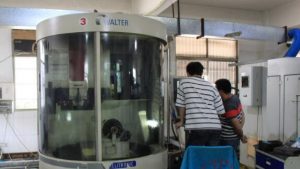
Call Plan’s technical expert Mike Plankey made a few comments on drilling holes on the cylinder. First, the center of the workpiece can be drilled with a center drill hole, so that drilling has an accurate starting point, the other is the use of cross-grinding drill bit drill, it can make the beginning of cutting edge immediately contact with the workpiece surface , To prevent drilling misalignment.
Precision drill company senior technician Jim Geske said that at least four self-centering drill-tip types are very effective for drills drilled on cylinders: helical face grinding, Bickford grinding, four facets And cross grinding.
Bickford grinding and spiral surface grinding are somewhat similar: have a spiral drill tip, if the thin-walled tube drilling tolerance requirements of more stringent hole, then use Bickford grinding type may be better, because the hole from the first See the protruding parts of the drill tip. With these two grinding type grinding of the drill tip, the horizontal edge of the formation of a raised height, which gives it self-centering ability. However, Geske said: “Bickford grinding is not suitable for the overall carbide bit, because this grinding requires about 9 different diameter diamond wheels, the cost is too high.” At this point the tool manufacturer should consider the selection of 60 ° or 90 ° (applied to the outer edge of the drill).
The four-plane grinding is also similar to the Bickford grinding and helical surface grinding, but it has two main horns and two second horns forming four planes, which form a self- The Geske says there are two types of four-plane grinding: four-sided overlap and four sides in the center. The width of the primary side is the same as the thickness of the core. At this time the main horn determines the horizontal edge of the drill bevel, naturally the greater the rear angle, the greater the horizontal edge bevel.




